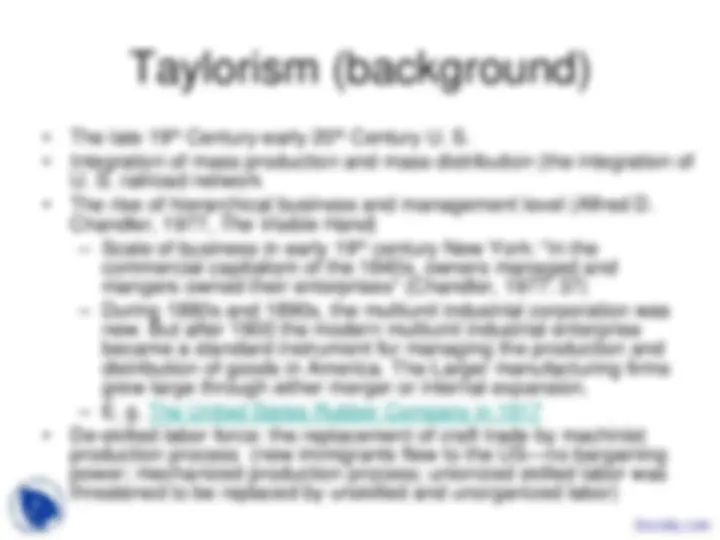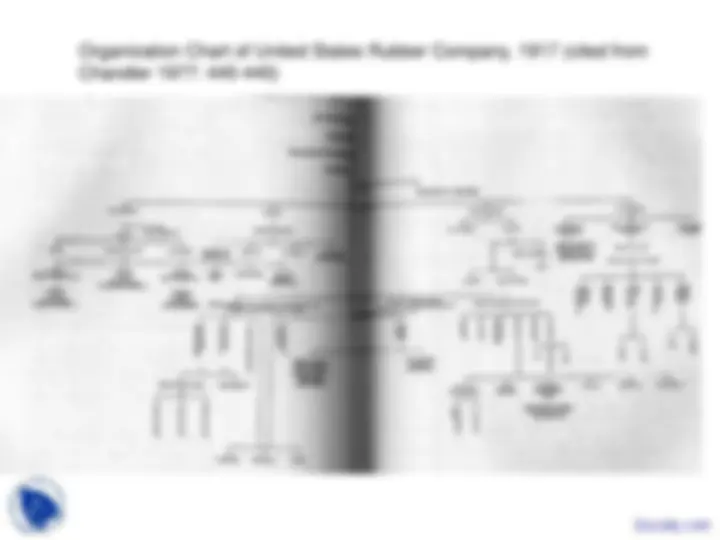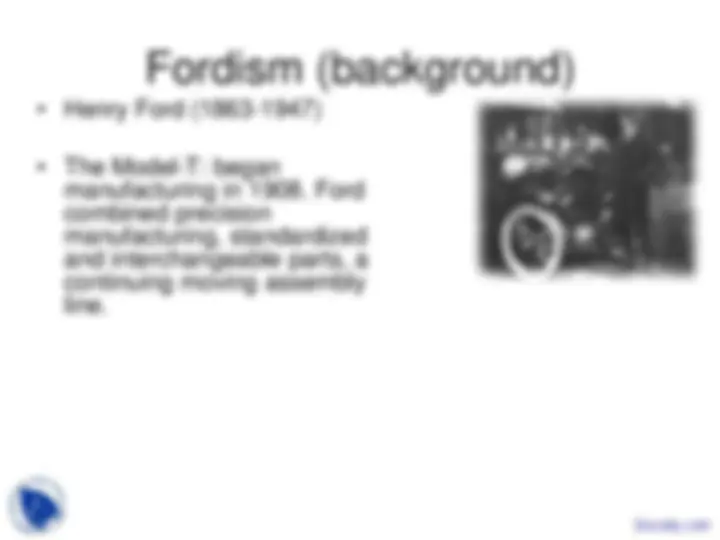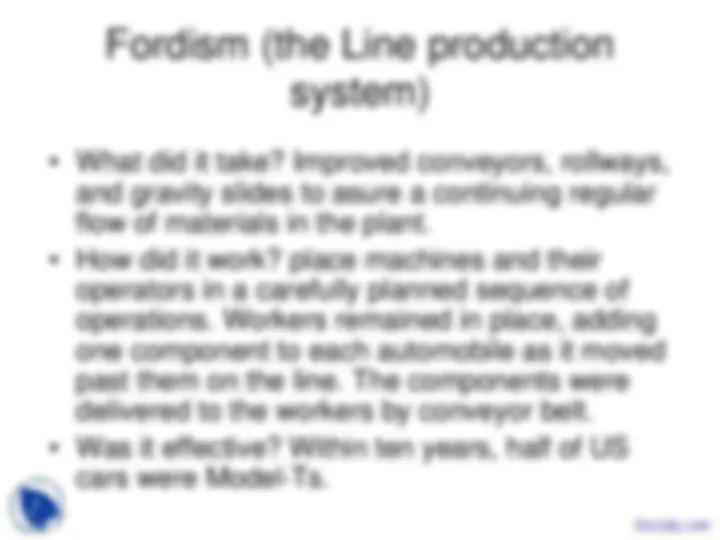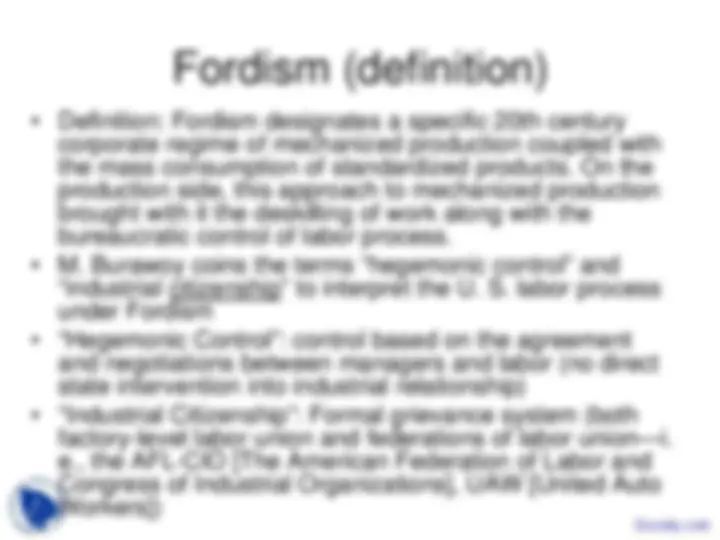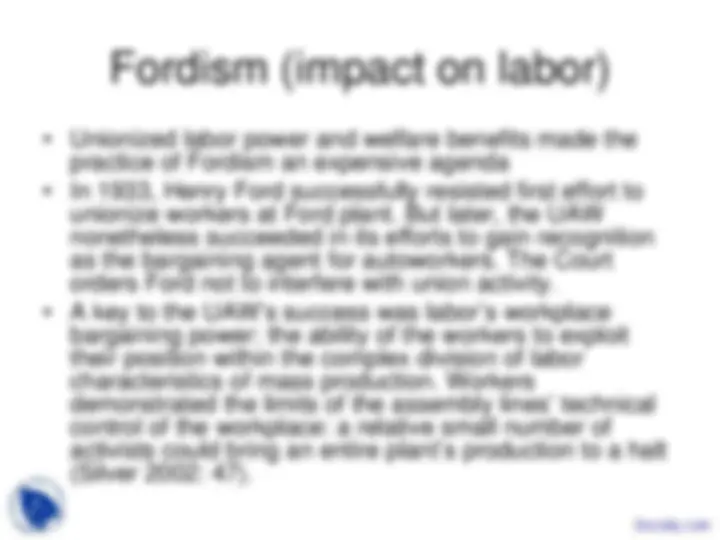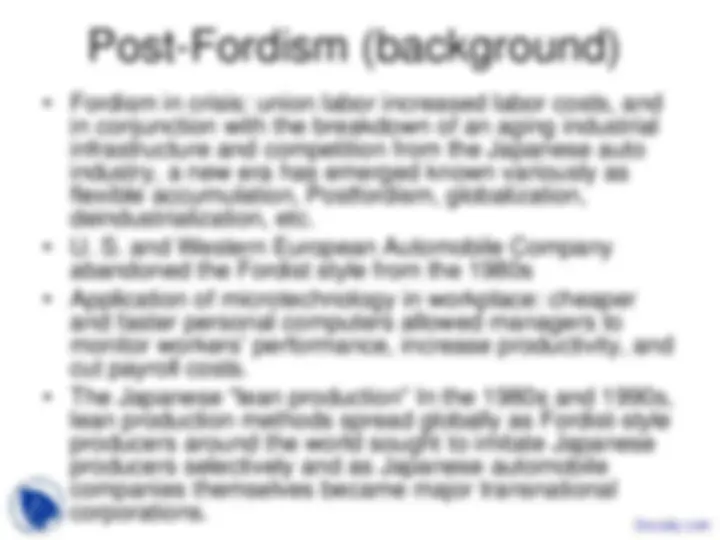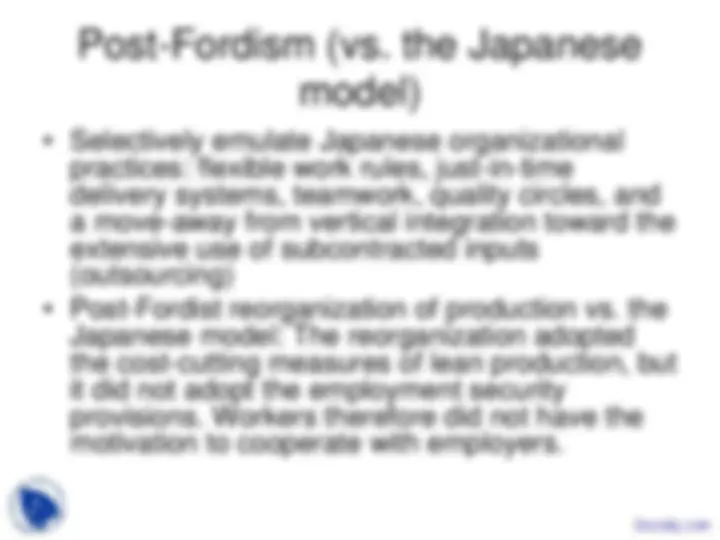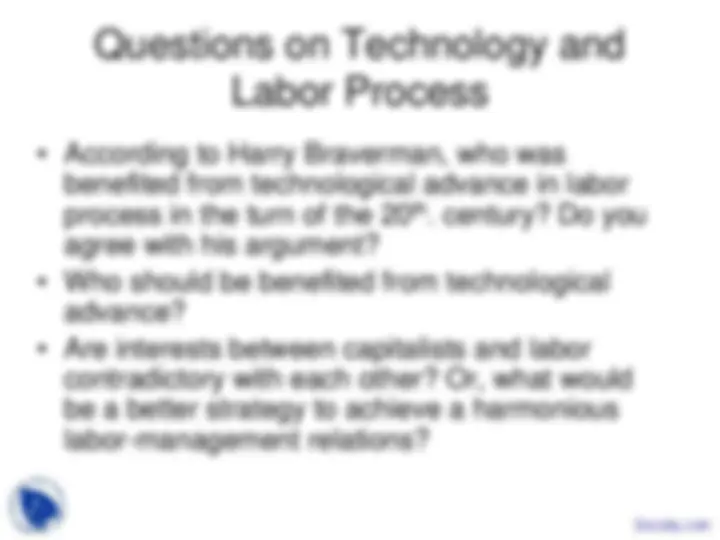Download Technology and the Shaping of Labor Processes: From Taylorism to Post-Fordism and more Slides Economic Sociology in PDF only on Docsity!
Lecture Note 4
Technology in Economic Life
Technology in Economic Life
• How technological advance shaped and
reshaped the labor process in the
twentieth century
• Taylorism (scientific management)
• Fordism (the demand-side economic
agenda)
• Post-Fordism and the supply-side
economic agenda
Taylorism (background)
- The late 19 th^ Century-early 20th^ Century U. S.
- Integration of mass production and mass distribution (the integration of U. S. railroad network
- The rise of hierarchical business and management level (Alfred D. Chandler, 1977, The Visible Hand ) - Scale of business in early 19 th^ century New York: “In the commercial capitalism of the 1840s, owners managed and mangers owned their enterprises” (Chandler, 1977: 37) - During 1880s and 1890s, the multiunit industrial corporation was new. But after 1900 the modern multiunit industrial enterprise became a standard instrument for managing the production and distribution of goods in America. The Larger manufacturing firms grew large through either merger or internal expansion. - E. g. The United States Rubber Company in 1917
- De-skilled labor force: the replacement of craft trade by machinist production process (new immigrants flew to the US—no bargaining power; mechanized production process; unionized skilled labor was threatened to be replaced by unskilled and unorganized labor)
Organization Chart of United States Rubber Company, 1917 (cited from Chandler 1977: 440-440)
Taylorism (principles)
- “A fair day’s work”: the maximum work that a worker can
accomplish in a day without injury to his health, at a pace that can be sustained throughout a working lifetime.
- First principle: the dissociation of the labor process from
the skills of the workers.
- Second principle: the separation conception from
execution
- Third principle: the use of the monopoly over knowledge
to control each step of the labor process and its mode of execution
Fordism (background)
- Henry Ford (1863-1947)
- The Model-T: began manufacturing in 1908. Ford combined precision manufacturing, standardized and interchangeable parts, a continuing moving assembly line.
Fordism (definition)
- Definition: Fordism designates a specific 20th century corporate regime of mechanized production coupled with the mass consumption of standardized products. On the production side, this approach to mechanized production brought with it the deskilling of work along with the bureaucratic control of labor process.
- M. Burawoy coins the terms “hegemonic control” and “industrial citizenship” to interpret the U. S. labor process under Fordism
- “Hegemonic Control”: control based on the agreement and negotiations between managers and labor (no direct state intervention into industrial relationship)
- “Industrial Citizenship”: Formal grievance system (both factory-level labor union and federations of labor union—i. e., the AFL-CIO [The American Federation of Labor and Congress of Industrial Organizations], UAW [United Auto Workers])
Fordism (definition)
- Mass production and mass consumption
- Under the circumstances that labor had to work
under the overall control of labor process and to
meet the high production requirement of mass
production, mass consumption market, labor
received higher incomes in return.
- The symbolic Ford’s “$ 5 a day” to workers: use
high salary to permit the mass owners of cars.
Workers were regarded as potential customers
of the products that produced.
Fordism (impact on labor)
- Unionized labor power and welfare benefits made the practice of Fordism an expensive agenda
- In 1933, Henry Ford successfully resisted first effort to unionize workers at Ford plant. But later, the UAW nonetheless succeeded in its efforts to gain recognition as the bargaining agent for autoworkers. The Court orders Ford not to interfere with union activity.
- A key to the UAW’s success was labor’s workplace bargaining power: the ability of the workers to exploit their position within the complex division of labor characteristics of mass production. Workers demonstrated the limits of the assembly lines’ technical control of the workplace: a relative small number of activists could bring an entire plant’s production to a halt (Silver 2002: 47).
Post-Fordism (background)
- Fordism in crisis: union labor increased labor costs, and in conjunction with the breakdown of an aging industrial infrastructure and competition from the Japanese auto industry, a new era has emerged known variously as flexible accumulation, Postfordism, globalization, deindustrialization, etc.
- U. S. and Western European Automobile Company abandoned the Fordist style from the 1980s
- Application of microtechnology in workplace: cheaper and faster personal computers allowed managers to monitor workers’ performance, increase productivity, and cut payroll costs.
- The Japanese “lean production” In the 1980s and 1990s, lean production methods spread globally as Fordist-style producers around the world sought to imitate Japanese producers selectively and as Japanese automobile companies themselves became major transnational corporations. Docsity.com
Post-Fordism (vs. the Japanese
model)
- Why didn’t Japan’s automobile industry not take the Fordist-style of production? Because Japan experienced a mass upsurge of labor militancy at the end of the W. W. II. (prior to the take-off of the Japanese automobile industry), the automobile producers chose to depart in significant ways from the Fordist style of mass production. Japan automobile producers established a multilayered subcontracting system that simultaneously allowed them to guarantee employment to a core labor force, while obtaining low-cost inputs and flexibility from the lower rungs of the supply network. This combination allowed Japan to escape the kind of labor unrest experienced by all the other major producers. It also allowed Japanese corporations to introduce a series of cost-cutting measures in the 1970s (the lean-production) and, hence, to triumph in the global competition of the 1980s(Based on Beverley Silver 2003, Ch. 2).
Post-Fordism (impacts on labor)
- Impacts on labor process:
- Relocation and emphasis on just-in-time production: Laid- off (or “stepping-down”), high-turnover strategy of mass production, anti-union policy
- See also the report from the Economist.
- The Saturn Model: A “beyond lean production” strategy? (Rinehart 2001: 190-191): the extensive web of collaboration between the company and the union. The company operates with join union-management decision- making bodies at various organizational levels, and the union is involved in decisions concerning supplier and dealer selection, choice of technology, and product development. Union representatives handled managerial responsibilities (which were used to be done by foremen and general foremen). Half middle managers are union members.


